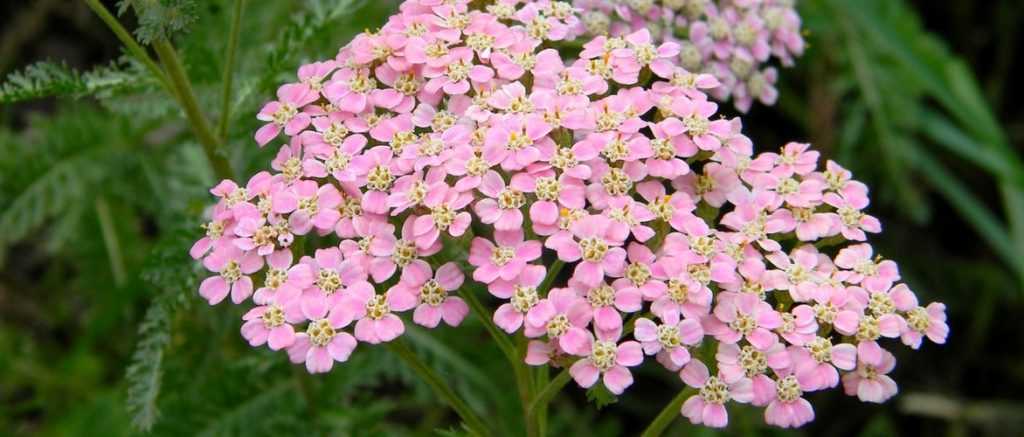
Yarrow, Achillea: Planting, Growing and Caring
Contents
Yarrow in a few words
- Yarrow captivates with its natural flowering that lasts all summer! It comes in a wide range of colours: from white to red, including bright yellow and mauve.
- It’s perfect for giving your garden a natural and wild look!
- A hardy and robust plant, it requires little attention, but its short lifespan means it needs regular division.
- Highly versatile, it boasts countless properties: it’s both a pollinator-friendly plant, a dye plant, edible and medicinal!
- The quintessential perennial for dry, sunny gardens, it thrives in poor, rocky, neglected soils where other plants won’t grow.
Our Expert's Word
Easy to grow, yarrow is a wonderful perennial whose summer flowering brings an irresistible natural and wild touch to the garden! Moreover, it’s an excellent medicinal plant with multiple properties. It also makes superb fresh or dried flower arrangements. A great companion plant to place near the vegetable garden, it attracts pollinators and repels pests!
The species type, Common Yarrow or Achillea millefolium, bears delicate white blooms. If it seems too pale for your taste, discover the horticultural varieties, which offer a wide range of colours, often in warm tones! It can take on bright yellow, red, pink or mauve hues. Yellow yarrow is very common, but whatever the colour, it fits perfectly into naturalistic gardens, wildflower meadows, sunny rockeries or borders. It’s unmatched for adding a splash of colour and dynamism to flower beds. We love it for its natural and wild character!
Yarrow is an excellent perennial to plant in hot, dry locations. Hardy, rarely affected by pests and diseases, it’s also resistant to heat and drought! It requires little attention. It’s even recommended to plant it near a vegetable garden, where it will repel harmful insects.
It’s an ideal plant for dry, poor and sunny soils! It needs little care and will charm you with its generous summer flowering. It can cover barren or hard-to-cultivate areas, neglected spots where other plants won’t grow. Once established, it spreads easily via rhizomes and self-seeds freely. So if your soil is dry and poor, take advantage! Rich soils, on the other hand, might make it more fragile.
Botany
Botanical data
- Latin name Achillea sp.
- Family Asteraceae
- Common name Achillée
- Flowering de juin à septembre
- Height 60 à 70 cm
- Exposure soleil
- Soil type drainant
- Hardiness - 20 à - 25 °C
The yarrow includes nearly 85 species of perennial plants, mostly deciduous. It is found in temperate zones of the Northern Hemisphere: mainly in Europe and Asia, but there are also some species in North America. Common yarrow (Achillea millefolium) is the most widespread species and also the most commonly planted! You can easily encounter it growing wild along pathsides. This beautiful meadow plant thrives on embankments and wastelands, frequently found in neglected areas with dry soil and full sun.
It belongs to the large Asteraceae family, which includes asters of course, but also numerous ornamental plants: from daisies to cosmos, including chrysanthemums, marigolds and other gazanias. Not to mention numerous wildflowers like daisies. It’s one of the most prolific horticultural families.
It owes its name to Achilles, the hero of Greek mythology, who allegedly used it to heal his wounds and those of his soldiers during the Trojan War. Its recognised medicinal properties have earned it many nicknames like Carpenter’s Herb or Soldier’s Woundwort.
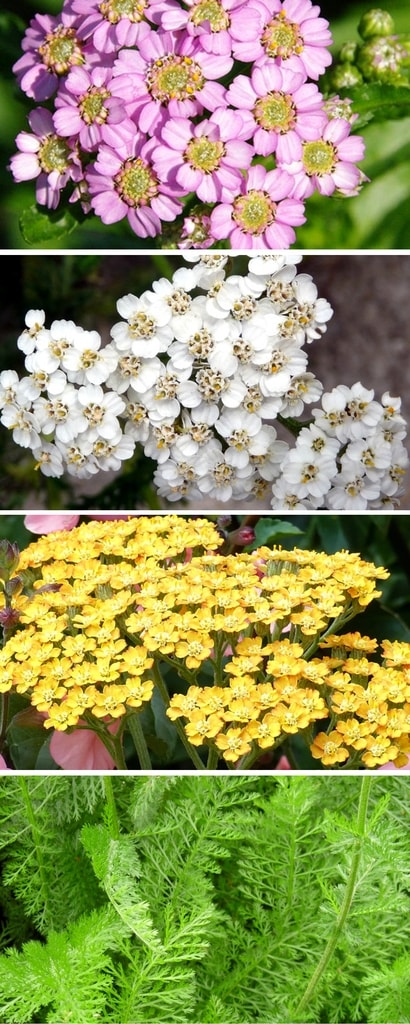
From top to bottom: flowers of Achillea sibirica ‘Love Parade’, Achillea millefolium, Achillea ‘Terracotta’ and leaves of Achillea millefolium ‘Desert Eve Red’
This herbaceous perennial spreads easily through its rhizomes and self-seeds readily! In good growing conditions, the common yarrow (Achillea millefolium) can even become invasive. It thrives and spreads without any maintenance!
It’s an excellent medicinal plant, long used for its many properties. It promotes healing, stops bleeding and relieves digestive disorders. It has antiseptic, antispasmodic and stimulant qualities. It’s one of the St. John’s herbs along with six other medicinal plants: mugwort, St. John’s wort, ground ivy, houseleek, daisy and sage. According to tradition, these plants were gathered on 24th June, very early in the morning when their medicinal properties were at their peak.
You can use yarrow as an infusion, tincture or compress on wounds. Harvest the flowers and make your own herbal teas! Best avoided in the evening due to its stimulant and tonic properties. Its leaves are edible: you can add them sparingly to salads as they’re slightly bitter. Choose young spring leaves which are more tender. They can also be eaten cooked.
It’s a good companion plant to grow near vegetable gardens. It repels certain harmful insects while attracting ladybirds, hoverflies, bees and butterflies. It’s also an excellent compost activator! It’s also used as a dye plant for natural dyes. Its flower heads produce yellow or greenish hues. Finally, yarrow makes effective macerations against fungal diseases and to strengthen plants’ natural resistance.
Harvest yarrow flowers to create stunning bouquets, both fresh and dried. They retain their colour when dried! Make beautiful arrangements by combining them with cosmos, baby’s breath, lavender or roses.
Yarrow tends to spread easily on its own, either by self-seeding or through its creeping rhizomes. Without maintenance, it will move around and naturalise in your garden. It can easily cover large areas!
It has upright, erect stems, unbranched or with very few branches. It typically grows about 60cm tall. Some varieties are ground-hugging, others very tall! The most compact reach 40cm, while taller varieties grow to 80cm, even up to 1.20m for Achillea filipendulina.
Yarrow bears terminal, flattened inflorescences in corymbs. These consist of numerous tiny flowers grouped into dense clusters. It flowers all summer, from June to September. In good growing conditions, it may produce a second flowering in autumn.
Although the most common species, common yarrow, has white or pinkish flowers, horticultural varieties are much more colourful! They display warm, vibrant hues: yellow, orange, red or pink. Some have softer, more delicate pastel tones: cream, pale pink, mauve, salmon… Certain varieties like Achillea ptarmica ‘The Pearl’ have double flowers like pompons! Others are even bicoloured, like Achillea ‘Strawberry Seduction’! An excellent nectar plant, yarrow attracts butterflies, bees, hoverflies and various pollinators.

Yarrow foliage! Top: Achillea ‘Moonshine’, bottom: Achillea millefolium
Common yarrow lives up to its name! Its leaves are extremely divided, appearing like numerous small leaflets, giving the whole plant a lovely light, feathery appearance. Some yarrow leaves are downy, covered in hairs, like Achillea tomentosa. They’re aromatic, pleasantly fragrant especially when crushed. They often resemble fern fronds, like the grey, slender leaves of Achillea clypeolata. The leaves of sneezewort (Achillea ptarmica) are narrow and entire, making them quite different from other species!
Unfortunately, yarrow leaves are deciduous and disappear in winter, though there are a few evergreen species rarely cultivated.
Yarrow spreads easily via its underground rhizomes. This makes propagation simple: just lift and divide clumps. Its spreading habit makes it useful as ground cover!
Yarrow produces tiny, flat, elongated seeds just a few millimetres long, contained in achenes.
Botanical species:
- Achillea millefolium
The most common species. It has white or pink flowers and finely divided foliage. It has given rise to countless colourful varieties! It spreads very easily via creeping rhizomes.
- Achillea ptarmica
Also called sneezewort. It prefers moist soil and lightly shaded positions. It produces pure white flowers, sometimes pompon-like in varieties such as ‘Perry’s White’ or ‘The Pearl’. Its leaves are entire, unlike most yarrows.
- Achillea filipendulina
This yarrow from Western Asia, particularly the Caucasus, is taller than other species (up to 1.20m!) with broader, denser flower heads. It has feathery foliage and striking bright yellow flowers!
The main varieties of yarrow
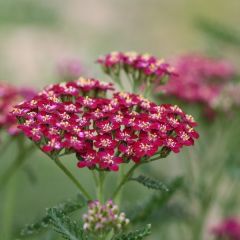
Achillea millefolium Cerise Queen
- Flowering time July to November
- Height at maturity 60 cm

Achillea millefolium Terracotta
- Flowering time July to October
- Height at maturity 75 cm
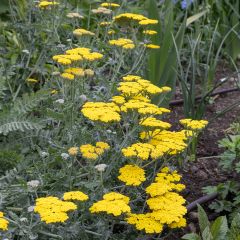
Achillea Moonshine
- Flowering time July to October
- Height at maturity 50 cm
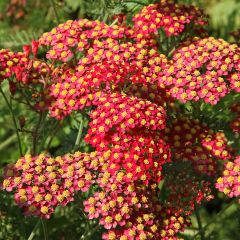
Achillea millefolium Paprika
- Flowering time July to November
- Height at maturity 60 cm
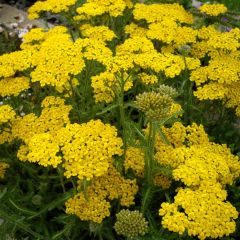
Achillea tomentosa
- Flowering time August, September
- Height at maturity 25 cm

Achillea fillipendulina Cloth of Gold
- Flowering time August to October
- Height at maturity 1,20 m

Achillea millefolium Lilac Beauty
- Flowering time August to October
- Height at maturity 60 cm

Achillea millefolium Walter Funcke - Yarrow
- Flowering time July to October
- Height at maturity 60 cm
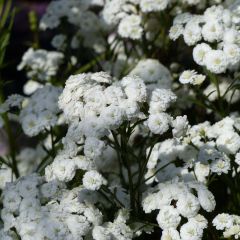
Achillea ptarmica Perrys White
- Flowering time July to October
- Height at maturity 60 cm
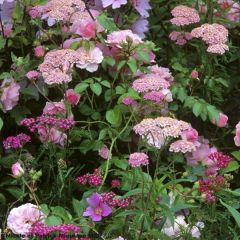
Achillea millefolium Apfelblüte
- Flowering time July to October
- Height at maturity 60 cm
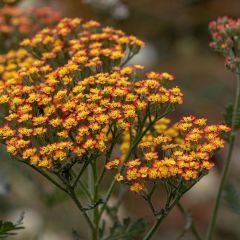
Achillea millefolium Feuerland
- Flowering time July to October
- Height at maturity 1 m
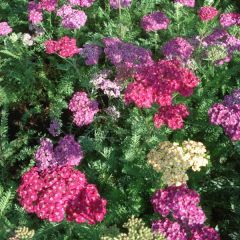
Achillea millefolium Saucy Seduction
- Flowering time July to October
- Height at maturity 50 cm
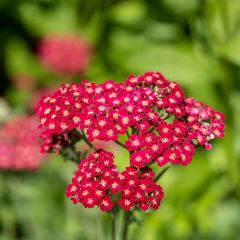
Achillea millefolium Red Velvet
- Flowering time August to November
- Height at maturity 60 cm
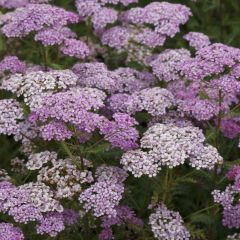
Achillea millefolium Excel
- Flowering time July to October
- Height at maturity 60 cm
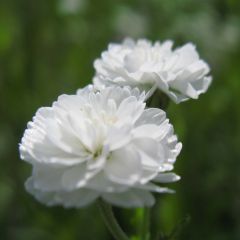
Achillea ptarmica The Pearl
- Flowering time August, September
- Height at maturity 30 cm
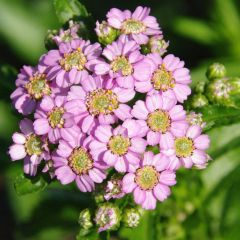
Achillea sibirica var. camtschatica Love Parade
- Flowering time July to October
- Height at maturity 60 cm
Discover other Achillea
Planting yarrow
Where to plant?
Yarrow thrives in full sun and light, well-draining soils. It can tolerate partial shade but will display more vibrant colours in full sun! It handles slightly chalky soils well and is perfectly suited to coastal gardens.
Plant your yarrow in groups! Unlike other flowers, yarrow isn’t meant to stand alone—it shines when planted en masse, creating a stunning wildflower meadow effect in your garden.
Fairly easy to grow, it will flourish as long as you meet one key requirement: good drainage. Yarrow detests waterlogged soil, so ensure the ground drains well! If your soil is heavy, mix in gravel or clay pebbles. It’s best planted in poor, dry soil. Overly rich or damp conditions will make your yarrow grow taller but weaker, causing it to flop. Stony or moderately sandy soil is no issue. However, not all yarrows have the same needs—Achillea ptarmica prefers moist soils, even damp conditions, and lightly shaded spots.
For taller varieties like Achillea filipendulina, choose a sheltered spot, such as near a hedge or against a house wall. Their height makes them prone to wind damage, so staking may be necessary.
Also read: Growing yarrow in pots – our advice.
When to plant?
Plant yarrow preferably in spring, around April through May. Autumn planting in September is also possible.
How to plant?
Plant in the ground, ideally in groups, spacing each plant about 30–40 cm apart.
- Soak the root ball in a bucket of water for at least 10 minutes.
- Loosen the soil and dig a planting hole. If your soil is heavy, improve drainage by adding a thin layer of gravel or clay pebbles to prevent waterlogging—yarrow hates stagnant water!
- Add a layer of soil to the planting hole.
- Position the root ball and backfill with soil.
- Ensure the base of the stem isn’t buried too deeply.
- Gently firm the soil and water. Yarrow establishes and spreads quickly.
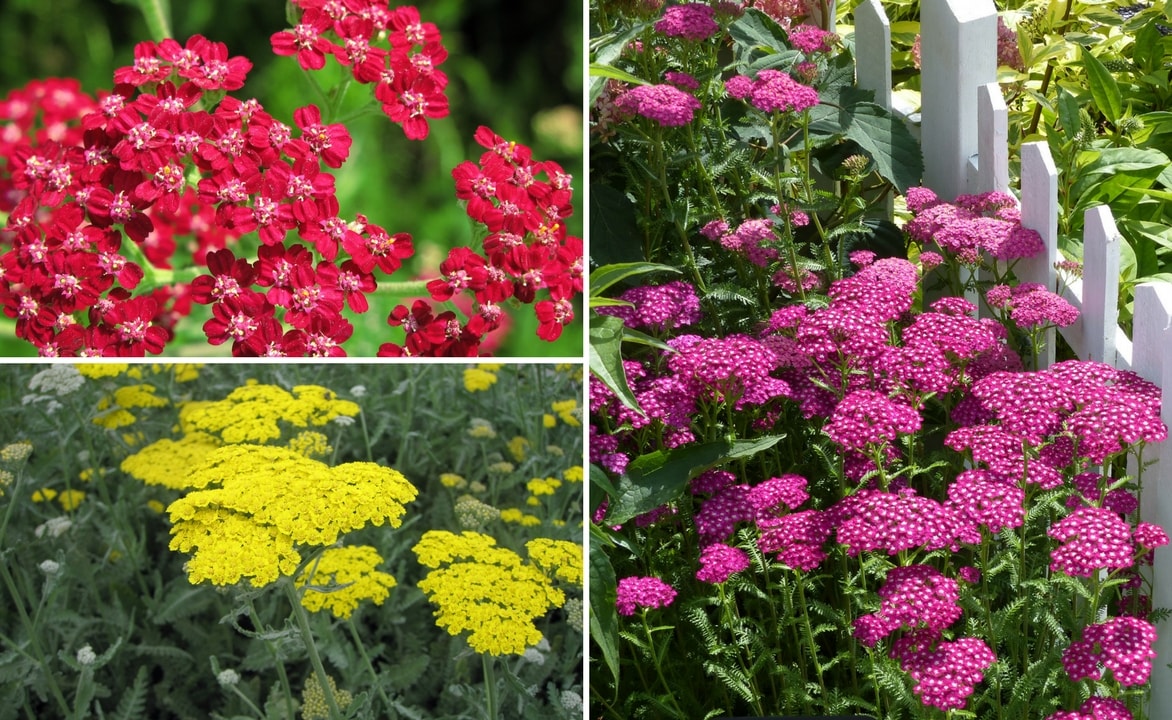
Yarrow sometimes displays strikingly bright and luminous hues!
Maintaining Yarrows
Highly hardy and drought-resistant, yarrows require little attention. As they are adapted to poor soils, they don’t need fertiliser. You may optionally add a thin layer of compost at their base in spring to encourage growth and flowering. Yarrows thrive in dry conditions and therefore rarely need watering – in most cases, they manage perfectly well on their own! Simply cut back spent flower stems. This helps prolong flowering by stimulating new blooms!
Extremely resilient plants, yarrows are rarely affected by diseases or pests! They may occasionally be attacked by aphids or powdery mildew. Achillea ptarmica is the most susceptible to powdery mildew. This fungal disease appears as a white coating covering the leaves.
You can harvest yarrow when it’s in full bloom. If you wish to dry the flowers for herbal teas or dried arrangements, hang them upside down, preferably in darkness, in a well-ventilated room.
We recommend cutting back the stems in spring before flowering to control their height and create a bushier, more compact plant. This is particularly important if grown in rich soil, where they might grow too tall, becoming fragile and prone to flopping. After flowering, cut back the stems hard in autumn.
Divide clumps every two to three years to maintain the plant’s vitality and vigour. This helps rejuvenate it and provides new plants!
Propagation
To propagate yarrow, you can either sow seeds or divide the plant. It tends to self-seed freely and can naturalise easily in the garden, though new seedlings may not flower in the same colour as the parent plant. Since yarrow is short-lived, we recommend preserving your plants by dividing them. Stem cuttings can also be taken in summer for propagation.
Sowing
Sow yarrow in spring, between April and June, once the risk of frost has passed. You can sow directly in the ground or in trays. If using trays, you can start earlier by placing them under a cold frame until temperatures rise. Seed propagation is an easy way to produce new plants.
Direct sowing
First, prepare the soil. Break up clumps, remove large stones, and refine the seedbed. Water lightly, then sow gently. Cover with a very thin layer of compost or sand—the seeds need light to germinate, so avoid burying them too deeply! Keep the soil moist until germination.
Sowing in trays
Starting seeds in trays allows you to get a head start by sowing earlier in the season under a cold frame.
Fill a tray with compost mixed with a little sand. Water to moisten the substrate, then sow. Do not cover the seeds—or if necessary, use just a fine sprinkling of compost or sand. Place the tray in a bright, warm spot, as yarrow needs light to germinate. Keep the substrate moist until germination, which may take one to two weeks. Transplant seedlings outdoors after the last frost.
Division
Divide yarrow clumps every two to three years in early spring, around April. This helps control and rejuvenate the plants, keeping them vigorous. Without regular division, they may spread beyond their original location. In ideal growing conditions, yarrow can even become invasive. Over time, undivided clumps may weaken and lose their beauty.
To divide, carefully lift young clumps, preserving as many roots as possible. Shake off excess soil and replant in loosened, well-worked soil. Firm in and water generously. They establish easily.
→ Learn more in our tutorial: How to Divide Yarrow
Association
Yarrows are perfect for integrating into a naturalistic garden, with a wild and free-spirited look! Plant them in groups for a more striking effect. Pair them with other plants featuring graphic and airy forms, such as ornamental grasses, Gaura lindheimeri, Verbena bonariensis, or Cirsium japonicum.
Being drought-tolerant and sun-loving, yarrows thrive in rock gardens. Opt for more compact varieties, such as Achillea tomentosa. Pair them with clumps of sedums, houseleeks, or saxifrages. Their drought resistance also makes them ideal for Mediterranean-style gardens. Combine them with grasses, santolinas, Jerusalem sage, and lavenders. This type of garden requires very little maintenance!
Yarrows can also be used in colourful mixed borders. Their countless varieties allow you to play with colours for stunning effects. Pair warm-toned plants, such as the ‘Terracotta’ yarrow, with dahlias or crocosmias. To add vibrancy to your beds, choose varieties with zesty hues, like Achillea ‘Moonshine’ or ‘Lilac Beauty’!
You can also create a beautiful naturalistic bed in warm tones by planting the ‘Terracotta’ variety alongside Eremurus ‘Cleopatra’, with its striking orange flower spikes, Selinum wallichianum, and the grass Stipa arundinacea.

A naturalistic scene in warm tones, featuring Achillea ‘Terracotta’, Eremurus ‘Cleopatra’, Selinum wallichianum, and Stipa arundinacea! (copyright GAP Photos Elke Borkowski)
Also check out our guide: “Yarrows: 7 Winning Plant Combinations”
Useful resources
Discover:
- Our wide range of yarrows
- Our video tips for planting perennials
- Our advice sheets:
- How to choose a yarrow?
- Yarrows: 7 successful planting combinations
- 7 red yarrows you must have in your garden
- 8 yellow yarrows
- 5 white yarrows you must have in your garden
- 7 pink yarrows you must have in your garden
- The most beautiful yarrows
- Green-leaved yarrows: how to use them and benefit from their garden advantages?
- Grey-leaved yarrows: a refined and original touch in the garden
- Our evergreen yarrows for a beautiful garden all year round
- Our advice on the best yarrows to use as ground cover
- Discover Yarrows: easy and drought-resistant perennials
- Subscribe!
- Contents
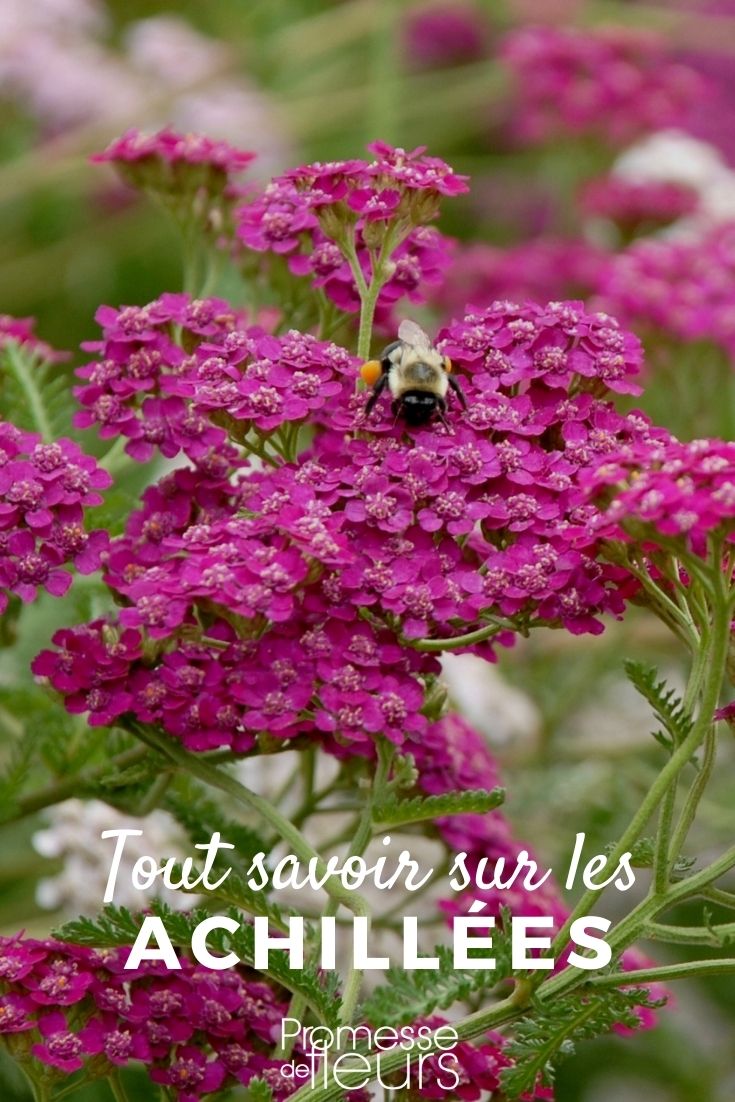


































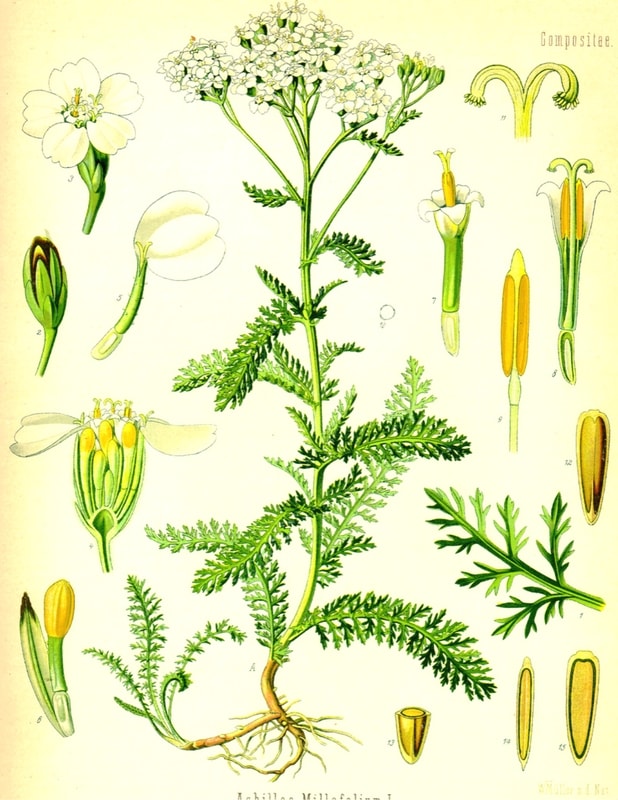
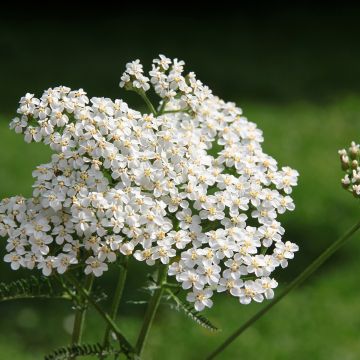

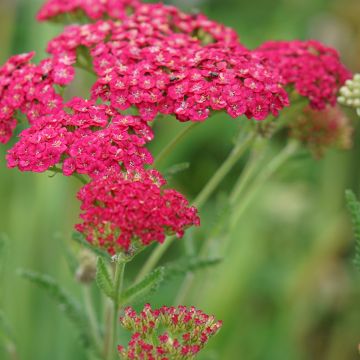





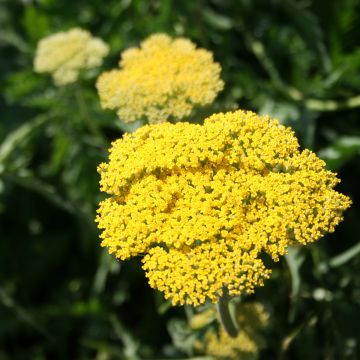

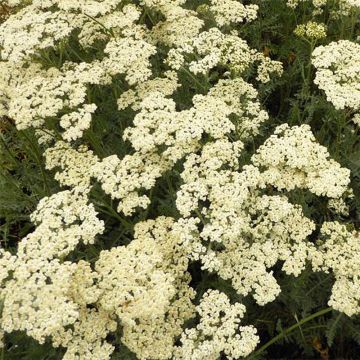

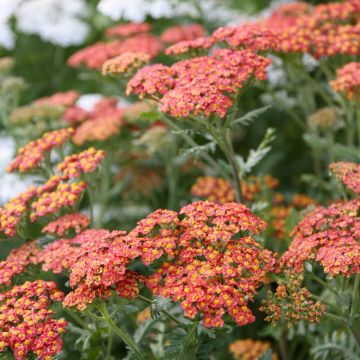
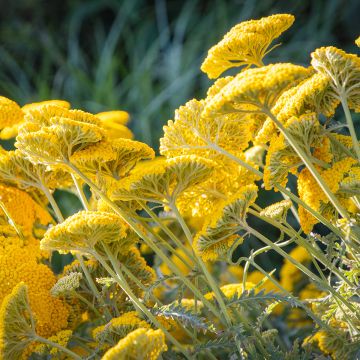


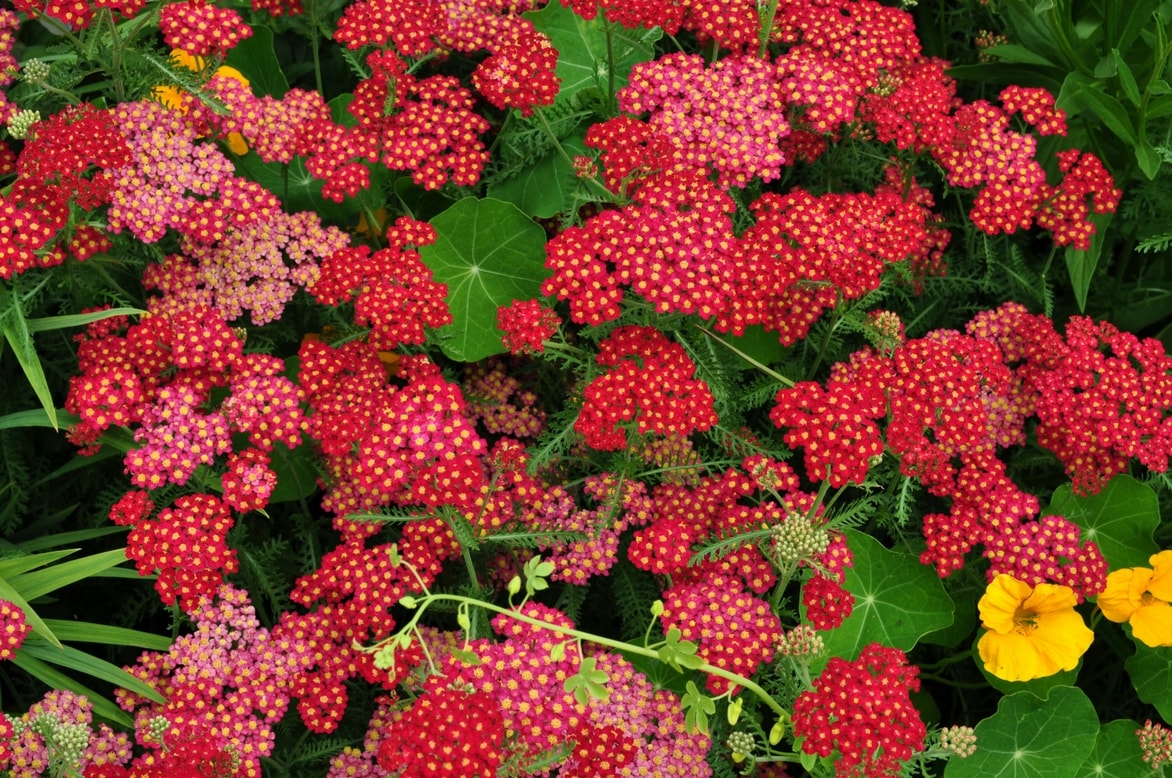
Comments